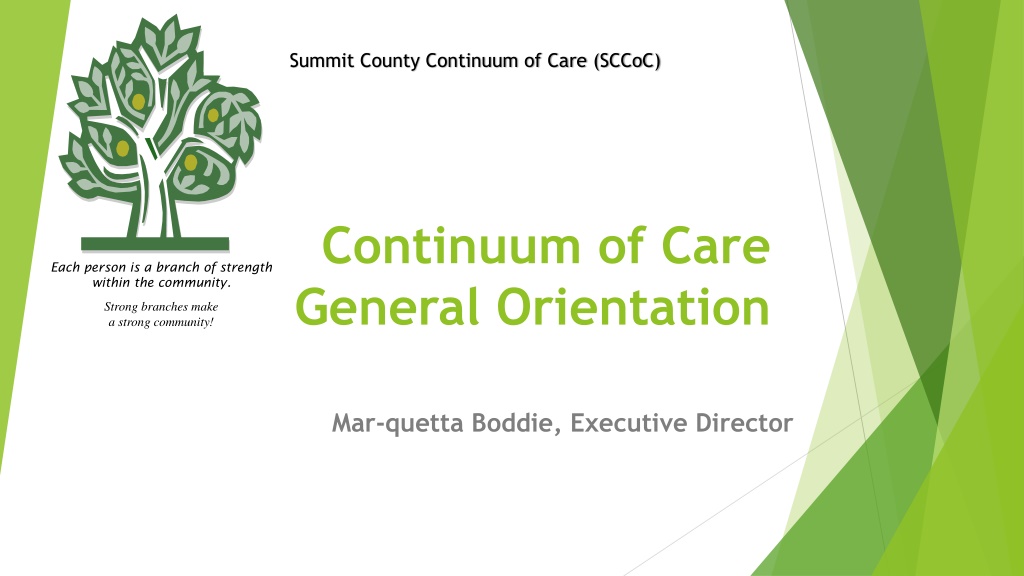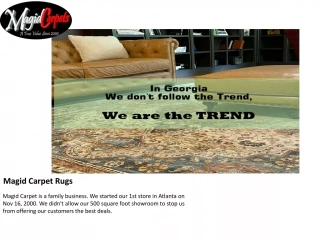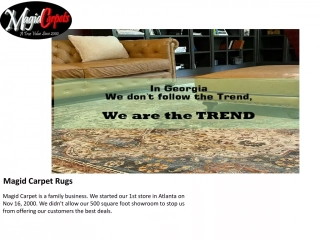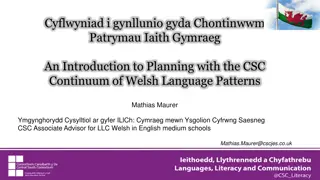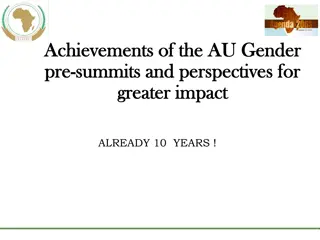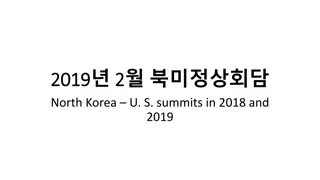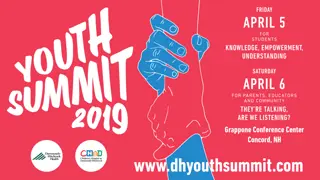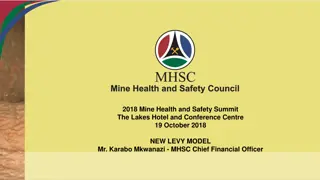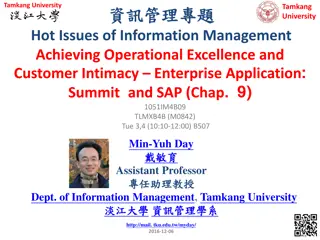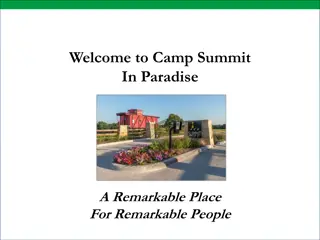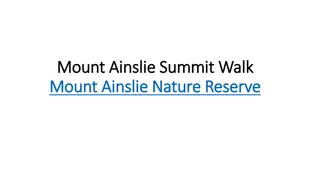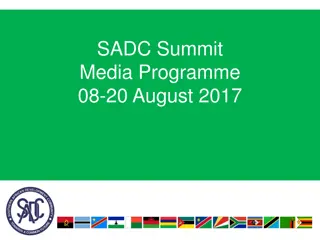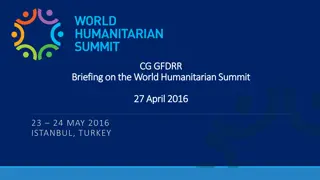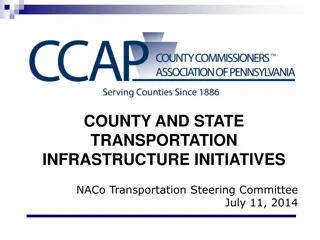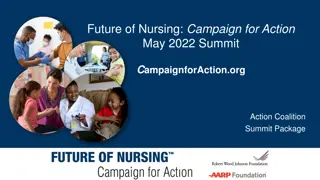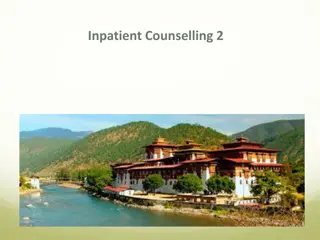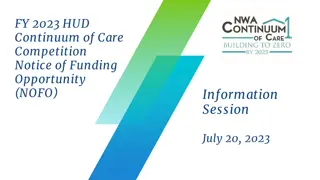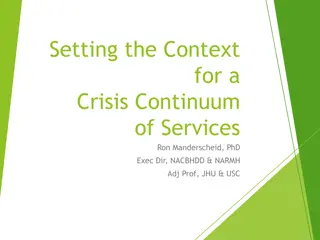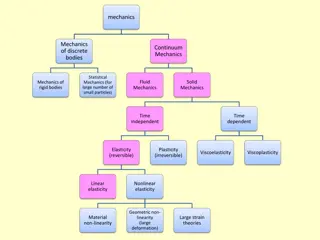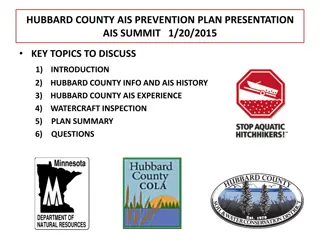Understanding Summit County Continuum of Care (SCCoC)
Learn about the Summit County Continuum of Care program, designed to end homelessness by providing funding for rehousing efforts and promoting access to mainstream programs. Discover the responsibilities of the CoC, the HMIS Lead Agency, and the importance of developing written standards and collaborative planning processes.
Download Presentation

Please find below an Image/Link to download the presentation.
The content on the website is provided AS IS for your information and personal use only. It may not be sold, licensed, or shared on other websites without obtaining consent from the author. Download presentation by click this link. If you encounter any issues during the download, it is possible that the publisher has removed the file from their server.
E N D
Presentation Transcript
Summit County Continuum of Care (SCCoC) Continuum of Care General Orientation Each person is a branch of strength within the community. Strong branches make a strong community! Mar-quetta Boddie, Executive Director
What is a Continuum of Care? The Continuum of Care (CoC) Program is designed to promote communitywide commitment to the goal of ending homelessness; provide funding for efforts by nonprofit providers and State and local governments to quickly rehouse homeless individuals and families while minimizing the trauma and dislocation caused to homeless individuals, families, and communities; promote access to, and effect utilization of, mainstream programs by homeless individuals and families; and optimize self-sufficiency among individuals and families experiencing homelessness
The term CoC is described in 2 ways To describe the Continuum of Care PROGRAM of the U.S. Department of Housing & Urban Development To describe the STRUCTURE required to be in place in a local community in order to access the program funds
HMIS Lead Agency (United Way) The HMIS (Homeless Management Information System) Lead Agency is the eligible CoC applicant designated by the CoC to oversee the day-to-day operations of the HMIS United Way carries out the HMIS Lead Agency responsibilities Summit County utilizes ServicePoint Management Information System (HMIS) as our Homeless
Responsibilities of the CoC/Operating the CoC Develop written standards to prioritize individuals and families eligible to receive the assistance, and the amount and type of assistance they should receive. Centralized Intake Establish performance expectations and monitor individual projects and system performance measures CoC responsibilities are outlined in the CoC Interim Rule, 24 C.F.R. Part 578
Responsibilities of the CoC/CoC Planning Develop a housing and service system Participate in the City of Akron and Summit County Consolidated planning processes Design and follow a collaborative process to select projects to apply for CoC funds
Centralized Intake Each Continuum of Care is required to develop and implement a centralized, or coordinated, entry system for its geographic area. United Way operates the homeless hotline through 211. Participation in the system is required of all CoC recipients and sub-recipients
CoC Program Eligible Project Applicants Nonprofits, states, local government, and instrumentalities of local government MUST be designated by the CoC to apply for funds Exclusion: for profits are not permitted to apply for grants or be subrecipient of grants
CoC Program Eligible Components 1.Permanent Housing a. Permanent Supportive Housing (PSH) b. Rapid Re-housing (RRH) 2.Transitional Housing Rapid Rehousing (TH-RRH) 3.Supportive Services Only (SSO) 4.Homeless Management Information System (HMIS) 5.Homelessness Prevention
Eligible Components: 1. Permanent Housing 1. Permanent Housing : Community based housing, the purpose of which is to provide housing without a designated length of stay. It includes: a. Permanent Supportive Housing (PSH) I. Programs formerly known as S+C II. Provides long-term housing assistance to homeless individuals and families in which one adult or child has a disability III. PSH Programs PRIORITIZE Chronically homeless individuals and families
Eligible Components: Permanent Housing b. Rapid Re-housing (RRH) I. Programs formerly known as scattered-site Transitional Housing II. Designed to help homeless individuals and families move as quickly as possible into permanent housing and achieve stability in that housing. III. Provides short and/or medium-term assistance (up to 24 months) IV. The program participants keep the housing/unit when assistance ends.
Eligible Components: Transitional Housing 2. Transitional Housing I. Programs designed to facilitate the movement of homeless individuals and families to Permanent Housing II. Program participants must MOVE to other housing when assistance ends. III. Program participants must have a lease or occupancy agreement with a term of at least one month that cannot be extended beyond 24 months
Eligible Components: 3. Supportive Services Only (SSO) I. Provide supportive services to unsheltered and sheltered homeless individuals and families (for whom the recipient/subrecipient is not providing housing or housing assistance). II. Includes Street Outreach and Coordinated Entry
Eligible Components: HMIS 4. Homeless Management Information System (HMIS) I. Provides assistance to CoC s in order to administer and operate the HMIS A Homeless Management Information System (HMIS) is a local information technology system used to collect client-level data and data on the provision of housing and services to homeless individuals and families and persons at risk of homelessness. Each Continuum of Care (CoC) is responsible for selecting an HMIS software solution that complies with HUD s data collection, management, and reporting standards. WellSky is the current vendor and Community Services (ServicePoint) is the HMIS software used to meet the HUD requirements for a data collection system for all HUD-funded homeless programs. United Way operates the HMIS of the Akron/Summit County program.
CoC Program Eligible Costs 1.Acquisition* 2.Rehabilitation* 3.New Construction* 4.Leasing 5.Rental Assistance 6.Supportive Services 7.Operating Costs 8.HMIS 9.Administration * Non-renewable
Acquisition Grant funds may be used to pay up to 100% of the cost of acquisition of real property selected by the recipient for use in the provision of housing or supportive services for homeless persons.
Rehabilitation Grant funds may be used to pay up to 100% of the cost of rehabilitation of structures to provide housing or supportive services to homeless persons. Eligible costs: installing cost-effective energy measures and bringing an existing structure to state and local government health and safety standards. Ineligible costs: grant funds may not be used for rehab of leased property.
New Construction Pay up to 100 % of the cost of new construction, including the building of a new structure or building an addition to an existing structure, and the cost of land associated with that construction for use as housing. If grant funds are used for new construction, the applicant must demonstrate that the costs of new construction are substantially less than the costs of rehabilitation or that there is a lack of available appropriate units that could be rehabilitated at a cost less than new construction. Ineligible costs: funds may not be used for construction on leased property.
Leasing Grant funds may be used to lease structures or individual units to provide housing or services to homeless persons Eligible Costs: Funds may be used to pay up to 100% of rent charged by property owner If utilities are included in rent, these utilities may be paid from leasing funds Security deposits, not to exceed 2 months of actual rent, may be paid on participant s behalf An advance payment of last month s rent may be provided to landlord in addition to the deposit Requirements: Leasing projects are required to have occupancy agreements and subleases (Recipient holds lease NOT program participant) Program can determine rent and it must be in compliance with guidance provided in federal regulations Occupancy charges and rent collected from program participants are considered program income. (Program Income must be expended before grant funds) Rents paid MUST be reasonable & can t exceed FMR Housing must be in compliance with Housing Quality Standards (HQS) throughout participant s stay in the unit and verified within 30 days of initial inspection and annually as unit receives assistance Projects receiving leasing assistance may not receive rental assistance, acquisition, rehab or construction funds.
Rental Assistance Grant funds may be used to provide short, medium, and long-term rental assistance. Eligible Costs: Rent Security deposits, not to exceed 2 months of actual rent, may be paid on participant s behalf An advance payment of last month s rent may be provided to landlord in addition to the deposit. Requirements: RRH rental assistance must be administered in accordance with policies and procedures established by the CoC. Rents paid MUST be reasonable Housing must be in compliance with Housing Quality Standards (HQS) throughout participant s stay in the unit and verified within 30 days of initial inspection and annually as unit receives assistance.
Supportive Services Grant funds may be used to pay the eligible costs of supportive services that address the special needs of the program participants. Requirements: Supportive services must be necessary to assist program participants obtain and maintain housing. Recipients shall conduct an annual assessment of the service needs of the program participants and should adjust services accordingly.
Operating Costs Grant funds may be used to pay the day-to-day operation of TH and PH housing in a single structure or individual units. Eligible Costs: Maintenance Property taxes and Insurance Scheduled payments to reserve for replacement of major systems Security Electricity, gas, and water Furniture Equipment Ineligible Costs: Funds may not be used for rental assistance and operating in the same project
Homeless Management Information System (HMIS) Grant funds may be used to pay the costs of contributing data to the HMIS designated by the Continuum of Care Eligible Costs: Paying salaries for operating HMIS, including: Completing data entry; Monitoring and reviewing data quality; Completing data analysis; Reporting to the HMIS Lead; Training staff on using the HMIS; and Implementing and complying with HMIS requirements
Administration The recipient or subrecipient may use up to 10% of the grant award for the payment of project administrative costs related to the planning and execution of the project. Ineligible: This does not include staff and overhead costs directly related to carrying out eligible activities because those costs are eligible as part of those activities. Eligible Costs: General management, oversight, and coordination of project Training on Continuum of Care requirements Environmental Review
Who can be served by CoC funded programs? A look at the definitions of homelessness: HUD published the Final Rule revising the definition of homeless on December 5, 2011. The definition is applicable to: Projects funded under the Emergency Solutions Grant New and Renewal Projects funded by CoC funds
Category 1 - Literally Homeless An individual or family who lacks a fixed, regular, and adequate nighttime residence; An individual or family with a primary nighttime residence that is a public or private place not designed for, or ordinarily used as, a regular sleeping accommodation for human beings An individual or family living in a supervised publicly or privately operated shelter designated to provide temporary living arrangements
Category 2 - At imminent risk of homelessness Individuals and families who will: Imminently lose their primary nighttime residence within 14 days AND Have no subsequent residence identified AND Lack the resources or support networks needed to obtain other permanent housing
Category 3 Homeless under other federal statute Unaccompanied youth under 25 or families with children and youth who do not otherwise qualify as homeless, but who: Meet homeless definition under other federal statute AND Have not had a lease, ownership interest, or occupancy agreement in permanent housing at any time during the last 60 days; AND Have experience two or more moves during the last 60 days; AND Can be expected to continue in such status for an extended period of time because of: Chronic disabilities, OR chronic physical health or mental health conditions, OR substance addiction, OR histories of domestic violence or childhood abuse (including neglect) OR presence of a child or youth with a disability, OR two or more barriers to employment
Category 4 Fleeing Domestic Violence Individuals and families who are fleeing, or are attempting to flee, domestic violence, dating violence, sexual assault, stalking, or other dangerous or life-threatening conditions related to violence, who: Have no identified subsequent residence; AND Lack the resources and support networks needed to obtain other permanent housing.
Important Notes on the Homeless Definition HUD designates that PSH programs can only serve persons who were homeless on the street or in a shelter NO category 2 CoC s must obtain HUD approval to serve Category 3, & our CoC does not have this approval NO category 3
Homeless Definition - Local Control Our local CoC prioritization and eligibility policies further limit who can be served in CoC programs RRH and TH program policies require that a person come from the street or shelter prior to entry Result: CoC & ESG programs can serve people in Categories 1 and 4 only: Street, Shelter & Fleeing Domestic Violence
Federal Definition Chronically Homeless Homeless individual with a disability AND Has been homeless continuously for at least 12 months OR on 4 separate occasions in the last 3 years. Combined occasions must total 12 months Occasions must be separated by a break of at least 7 nights Stays in institutions of fewer than 90 days do not constitute a break
CoC System Performance 1. Length of time persons remain homeless 2. The extent to which persons who exit homelessness to PH destinations return to homelessness (recidivism) 3. Number of homeless persons 4. Employment and income growth for homeless persons in CoC program- funded projects 5. Number of persons who become homeless for the 1st time 6. Not Applicable at this time- Homeless prevention and housing placement of persons defined by category 3 of HUD s homeless definition in CoC program- funded projects 7. Successful placement from street outreach and successful placement in, or retention of, permanent housing
How does a program get into our CoCs application to HUD Threshold Requirements Must haves to apply Performance Measures Renewal Projects CoC Ranking & Review Committee Ranking & Review s programs outcomes and other criteria to determine funding allocation.
Threshold Requirements New AND Renewals New Projects CoC Application Is your organization compliant with the CoC Priorities Renewals Performance Measures and Compliance Project must operate in compliance & meet performance measured standards ALL PROJECTS Match All funds, except leasing, must be matched with no less than 25% of funds, or in-kind contributions, from other sources on a grant-by-grant basis.
Pre-measured Elements (Ranking) (Renewals Only) HMIS Data Quality Housing Outcomes Income Outcomes Employment/Benefit Outcomes Unspent Funds Length of Stay Ranking & Review Committee members rank projects in order of highest priority for our community
National Scoring of CoC Application by HUD (OH-506) CoC Application Encompasses everything the CoC does and produces year-round Written by CoC Manager or Lead Agency and CoC steering committee & reviewed by the CoC Board Scored nationally by HUD in Washington Project Application Written by agencies requesting new or renewal grants Submitted by CoC Manger or Lead Agency Must pass a capacity review conducted by the HUD Field Office Scored nationally by HUD in Washington
Bonus Funding Determined annually by the CoC Notice of Funding Availability (NOFO)
Questions? Executive Director, Mar-quetta Boddie mboddie@summitcoc.org Community Engagment Cooridnator, Megan Duke mduke@summitcoc.org
